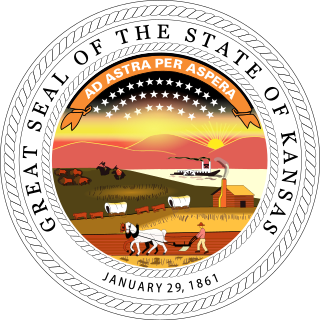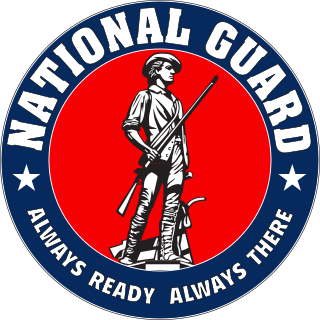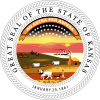It has been requested that the title of this article be changed to List of governors of Kansas . Please see the relevant discussion on the discussion page. The page should not be moved unless the discussion is closed; summarizing the consensus achieved in support of the move. |
| Governor of Kansas | |
|---|---|
 | |
 Standard of the Governor | |
| Residence | Cedar Crest |
| Term length | Four years, renewable once |
| Inaugural holder | Charles L. Robinson |
| Formation | February 9, 1861 |
| Salary | $99,636 (2017) [1] |
| Website | governor |
The Governor of Kansas is the head of the executive branch of Kansas's state government [2] and the commander-in-chief of the state's military forces. [3] The governor has a duty to enforce state laws, [2] and the power to either approve or veto bills passed by the Kansas Legislature, [4] to convene the legislature at any time, [5] and to grant pardons. [6]

The government of the U.S. state of Kansas, established by the Kansas Constitution, is a republican democracy modeled after the Federal Government of the United States. The state government has three branches: the executive, the legislative, and the judicial. Through a system of separation of powers, or "checks and balances," each of these branches has some authority to act on its own, and also some authority to regulate the other two branches, so that all three branches can limit and balance the others' authority.

The Kansas National Guard, is the component of the United States National Guard in the U.S. state of Kansas. It comprises both the Kansas Army National Guard and the Kansas Air National Guard. The Governor of Kansas is Commander-in-Chief of the Kansas National Guard when in state use. The State's highest-ranking military commander, the Adjutant General of Kansas, serves as the military head of the Guard and is second only to the Governor.

The Kansas Legislature is the state legislature of the U.S. state of Kansas. It is a bicameral assembly, composed of the lower Kansas House of Representatives, with 125 state representatives, and the upper Kansas Senate, with 40 state senators. Representatives are elected for two-year terms, senators for four-year terms.
Contents
- History
- Gubernatorial term of office and lack of requirements for running
- Residence
- Governors
- Governors of Kansas Territory
- Governors of Kansas
- See also
- Notes
- References
- External links
The governor has a four-year term, commencing on the second Monday of January after election. [7] The governor originally had a two-year term; this was changed to four years by a constitutional amendment in 1974. The lieutenant governor is elected at the same time as the governor. [7] When the office of governor becomes vacant for any reason, the lieutenant governor becomes governor for the remainder of the term. [8]
Since becoming a state, Kansas has had 47 governors. The state's longest-serving governors were Robert Docking, John W. Carlin, and Bill Graves, each of whom served 8 years and 4 days (Docking served four two-year terms; Carlin and Graves each served two four-year terms). The shortest-serving governor was John McCuish, who served only 11 days after the resignation of Fred Hall.
Robert Blackwell Docking was the 38th Governor of Kansas from 1967 until 1975.

John William Carlin is an American politician. He served as the 40th Governor of Kansas from 1979 to 1987, and the Archivist of the United States from May 30, 1995, to February 15, 2005. He teaches at Kansas State University and operates a website to advance civic engagement. Carlin is also a member of the ReFormers Caucus of Issue One.

William Preston Graves is a former American politician who was the 43rd Governor of Kansas from 1995 until 2003.
The current governor is Democrat Laura Kelly, who took office on January 14, 2019.

Laura Kelly is an American politician who is the 48th governor of Kansas, serving since January 2019. A member of the Democratic Party, she represented the 18th district in the Kansas State Senate from 2005 to 2019. Kelly ran for governor in the 2018 election and defeated the Republican nominee, Kansas Secretary of State Kris Kobach.






















































